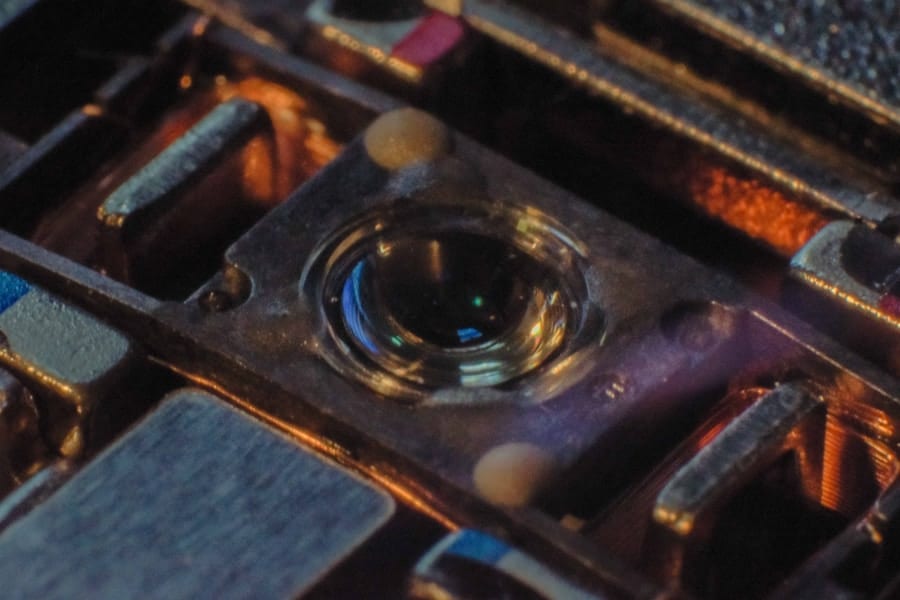Spin qubits represent a fascinating frontier in the realm of quantum computing, leveraging the intrinsic angular momentum of electrons or nuclei to encode information. Unlike classical bits, which exist in a state of either 0 or 1, qubits can exist in superpositions of these states, allowing for a vast increase in computational power. The concept of spin qubits is rooted in quantum mechanics, where the spin of a particle can be thought of as a tiny magnet that can point either up or down, corresponding to the binary states.
This duality enables qubits to perform complex calculations at unprecedented speeds, making them a cornerstone of future quantum technologies. The appeal of spin qubits lies not only in their ability to represent information but also in their relatively long coherence times compared to other qubit types. Coherence time refers to the duration over which a qubit maintains its quantum state before succumbing to decoherence, which is the loss of quantum information due to interactions with the environment.
Spin qubits can be implemented in various physical systems, including semiconductor quantum dots, trapped ions, and even diamond-based systems with nitrogen-vacancy centers. Each of these platforms offers unique advantages and challenges, contributing to the rich tapestry of research and development in the field.
Key Takeaways
- Spin qubits are quantum bits that use the spin of electrons or nuclei to store and process information, offering potential advantages in quantum computing.
- Spin qubits have the potential to revolutionize quantum computing by enabling longer coherence times, reduced error rates, and scalability for large-scale quantum systems.
- Challenges in spin qubit technology include maintaining coherence and controlling individual qubits, but advances in materials and fabrication techniques are addressing these issues.
- Spin qubits also show promise in quantum sensing and metrology, offering high sensitivity for detecting magnetic fields and other environmental factors.
- In quantum communication and simulation, spin qubits can enable secure and efficient information transfer and the simulation of complex quantum systems, opening up new possibilities for practical applications in quantum devices.
The Potential of Spin Qubits in Quantum Computing
The potential of spin qubits in quantum computing is immense, primarily due to their scalability and compatibility with existing semiconductor technologies. As researchers strive to build larger and more complex quantum processors, spin qubits offer a pathway to integrate quantum computing with classical computing infrastructures. For instance, semiconductor-based spin qubits can be fabricated using techniques similar to those employed in traditional microelectronics, facilitating the transition from laboratory prototypes to practical applications.
Moreover, spin qubits exhibit remarkable gate fidelity, which is crucial for executing quantum algorithms accurately. High-fidelity operations are essential for error correction schemes that are necessary for practical quantum computing. Recent advancements have demonstrated that spin qubits can achieve gate fidelities exceeding 99%, making them competitive with other qubit implementations.
This level of precision is vital for executing complex quantum algorithms that require multiple operations on qubits without introducing significant errors.
Challenges and Advances in Spin Qubit Technology

Despite their promise, the development of spin qubit technology is not without challenges. One significant hurdle is the issue of scalability. While individual spin qubits can be controlled with high precision, connecting multiple qubits to form a larger quantum circuit introduces complexities related to crosstalk and coherence preservation.
Researchers are actively exploring various architectures and control schemes to mitigate these issues, such as using microwave pulses for coherent manipulation and developing advanced error correction techniques. Another challenge lies in the material properties and fabrication processes used to create spin qubits. The quality of the materials directly impacts the coherence times and operational fidelity of the qubits.
For example, impurities in semiconductor materials can lead to unwanted interactions that degrade performance. Advances in material science, such as the development of high-purity silicon or novel two-dimensional materials like graphene, are being investigated to enhance the performance of spin qubits. These innovations aim to create more robust qubit systems that can operate reliably under practical conditions.
Spin Qbits in Quantum Sensing and Metrology
Beyond their role in quantum computing, spin qubits have emerged as powerful tools in quantum sensing and metrology. Quantum sensors exploit the sensitivity of quantum states to external perturbations, enabling unprecedented precision in measurements. Spin qubits can be utilized to detect magnetic fields, electric fields, and even temperature changes with remarkable accuracy.
For instance, nitrogen-vacancy centers in diamond have been employed as magnetic field sensors capable of detecting single electron spins, making them invaluable for applications in materials science and biology. The ability of spin qubits to serve as highly sensitive sensors stems from their unique quantum properties. When a spin qubit interacts with an external magnetic field, it experiences shifts in its energy levels that can be measured with high precision.
This sensitivity allows researchers to probe nanoscale phenomena and gain insights into complex systems that were previously inaccessible. As advancements continue in this area, spin qubits are poised to revolutionize fields such as medical imaging, where they could enhance the resolution of magnetic resonance imaging (MRI) techniques.
Spin Qubits in Quantum Communication
Quantum communication represents another exciting application for spin qubits, particularly in the realm of secure information transfer. The principles of quantum mechanics enable the creation of secure communication channels through protocols such as quantum key distribution (QKD).
One notable example is the use of spin qubits in entangled states for secure communication. By generating pairs of entangled spin qubits, it becomes possible to share information between distant parties while ensuring that any attempt at interception would disturb the entangled state, alerting the communicating parties to potential security breaches. This capability has profound implications for secure data transmission across various sectors, including finance and national security.
Spin Qubits in Quantum Simulation

Quantum simulation is another domain where spin qubits hold significant promise. Quantum simulators leverage the unique properties of quantum systems to model complex physical phenomena that are challenging for classical computers to simulate accurately. Spin qubits can be arranged into tailored configurations that mimic various quantum systems, enabling researchers to explore fundamental questions in condensed matter physics and materials science.
For instance, researchers have successfully used arrays of spin qubits to simulate magnetic interactions and phase transitions in materials. By tuning the interactions between qubits, scientists can replicate the behavior of electrons in solid-state systems, providing insights into phenomena such as superconductivity or magnetism. This capability not only enhances our understanding of fundamental physics but also paves the way for discovering new materials with tailored properties for technological applications.
Applications of Spin Qubits in Quantum Devices
The versatility of spin qubits extends beyond theoretical applications; they are increasingly being integrated into practical quantum devices. Quantum processors based on spin qubits are being developed with the aim of performing specific tasks more efficiently than classical counterparts. For example, certain optimization problems that are computationally intensive for classical computers may be solved more effectively using quantum algorithms executed on spin-based processors.
Additionally, hybrid systems that combine spin qubits with other types of qubits or classical components are being explored to enhance performance and functionality. Such hybrid architectures could leverage the strengths of different qubit types while mitigating their weaknesses. For instance, integrating superconducting qubits with spin qubits could lead to improved coherence times and operational fidelity, creating a more robust platform for quantum computation.
Future Developments and Opportunities in Spin Qubit Research
Looking ahead, the future of spin qubit research is filled with opportunities for innovation and discovery. As researchers continue to refine fabrication techniques and explore new materials, we can expect significant advancements in coherence times and gate fidelities. The integration of machine learning algorithms into quantum control systems may also enhance our ability to manipulate spin qubits with greater precision and efficiency.
Moreover, interdisciplinary collaborations between physicists, engineers, and computer scientists will play a crucial role in advancing spin qubit technology. By combining expertise from various fields, researchers can tackle complex challenges related to scalability and error correction more effectively. As we stand on the brink of a new era in quantum technology, spin qubits are poised to be at the forefront of this revolution, driving advancements across computing, sensing, communication, and simulation domains.
The ongoing exploration of their potential will undoubtedly yield transformative applications that could reshape our technological landscape for years to come.
A related article to “How Spin Qubits Are Advancing the Future of Quantum Devices” is the review of NeuronWriter, the best content SEO optimization tool. NeuronWriter can help businesses improve their online presence and reach a wider audience through optimized content. To learn more about this powerful tool, check out the article here.
FAQs
What are spin qubits?
Spin qubits are a type of qubit, the basic unit of quantum information, that use the spin of an electron or nucleus as the basis for quantum computing. They can be manipulated and measured using magnetic fields, making them a promising candidate for building quantum devices.
How are spin qubits advancing the future of quantum devices?
Spin qubits have the potential to revolutionize quantum computing by offering a scalable and manufacturable platform for building quantum devices. Their ability to retain quantum information for longer periods of time and their compatibility with existing semiconductor technology make them a promising avenue for advancing the field of quantum computing.
What are the advantages of spin qubits over other types of qubits?
Spin qubits have several advantages over other types of qubits, including their potential for scalability, longer coherence times, and compatibility with existing semiconductor technology. These advantages make spin qubits an attractive option for building practical and reliable quantum devices.
What are some of the challenges in developing spin qubits for quantum devices?
One of the main challenges in developing spin qubits for quantum devices is achieving the level of control and precision required for reliable quantum operations. Additionally, maintaining the coherence of spin qubits in a noisy environment and integrating them with other quantum components are also areas of active research and development.
How do spin qubits differ from superconducting qubits?
Spin qubits and superconducting qubits are two different approaches to building quantum devices. While superconducting qubits rely on the manipulation of electrical circuits, spin qubits use the spin of electrons or nuclei as the basis for quantum information. Each approach has its own advantages and challenges, and both are being actively pursued in the field of quantum computing.

